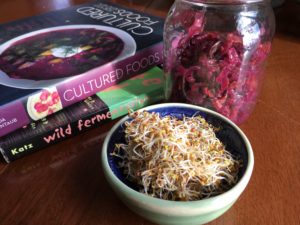By Kay Aihla McGrenaghan Cafasso
Permaculture design and gardening continues all year, even when the growing season is at rest. It is essential to continually ask: How we can we be more efficient with our time and energy, live with greater health consciousness, meanwhile working with our locally available resources.
Looking ahead towards the 2017 gardens, it is helpful to consider during mid- winter:
- What foods do we wish we had grown more of?
- Is there enough dried tea or garlic stored for our family? What medicines can we grow at home, infusing our care into our own backyard ‘farmacy’?
- Would a root cellar be feasible as a new structure or can we insulate an area in the cellar?
- What fresh greens can we grow on our windowsill or counter top?
- Where is the best location for a cold frame to access fresh, cold hardy greens in the snow?
- What foods shall we grow for fermentation in our garden?
- Do we need to plant more native pollinator habitat or more at risk plants?
- Are we doing our part to sequester carbon in our home landscape?
The answers to these questions will influence our design for next year. We are looking at the successes and failures of the previous season, considering the whole system of time management, volume and quality of our harvest, resource and nutrient cycling, placement of elements for the most efficient relative location, etc. Of course, we are also looking at areas that we have not yet considered as potential for food production until now, and surveying soil, light, slope, access, and water conditions. Now is the perfect time to dream up our ‘yarden’, a yard turned into a garden! We want to spring right in with spring weather, so meeting with permaculture designers for an onsite consultation, perusing seed catalogs with friends, or attending a permaculture training course yourself are great ways to start while the land is covered in snow.
Permaculture design also applies to the layout of space and place in our home. While we may be missing the activities of the growing season, we can set up these areas during winter:
- Dry herbs in a shaded and well ventilated area; dry fruits with a dehydrator; set up fermentation crocks to make sauerkraut, beet kraut, kimchi, or brew healthy drinks like beet kvas, etc.;
- Start a worm bin for vermi-compost in or near the kitchen (don’t worry, it won’t smell bad as long as you balance the moisture level correctly, and the worms won’t climb out since they prefer darkness under the soil);
- Set up buckets of sand in a cold room or cellar and store root crops (once harvested from the field they can be placed carefully in damp sand, don’t allow any vegetable to touch a neighboring vegetable, nor the wall of the bucket, to prevent them from rotting). If space allows, set up a larger root cellar, or join a local winter CSA;
- Sprout seeds and beans for fresh nutrition grown locally at home;
- Save money by making your own elderberry syrup and fire cider to keep your immune system strong.
A good permaculture design integrates your lifestyle with the specific site conditions, so during winter it is important to note how rewards of the growing season are felt in the kitchen and in our bodies. A good permaculture design also opens up many possible healthy adjustments to our lifestyle that stem from our own abundant landscape. When making decisions about how to facilitate a landscape, there is a kind of magic we can strike. This magic happens when we balance the two influences of site possibilities and our lifestyle, since they continually and reciprocally inform one another.
Kay Aihla McGrenaghan Cafasso is the Director of Sowing Solutions, a permaculture design and educational center based in Western Massachusetts. Learn more about the permaculture design certification courses and ecological design services at www.PermacultureSeries.org and www.SowingSolutions.org.










Leave a Reply